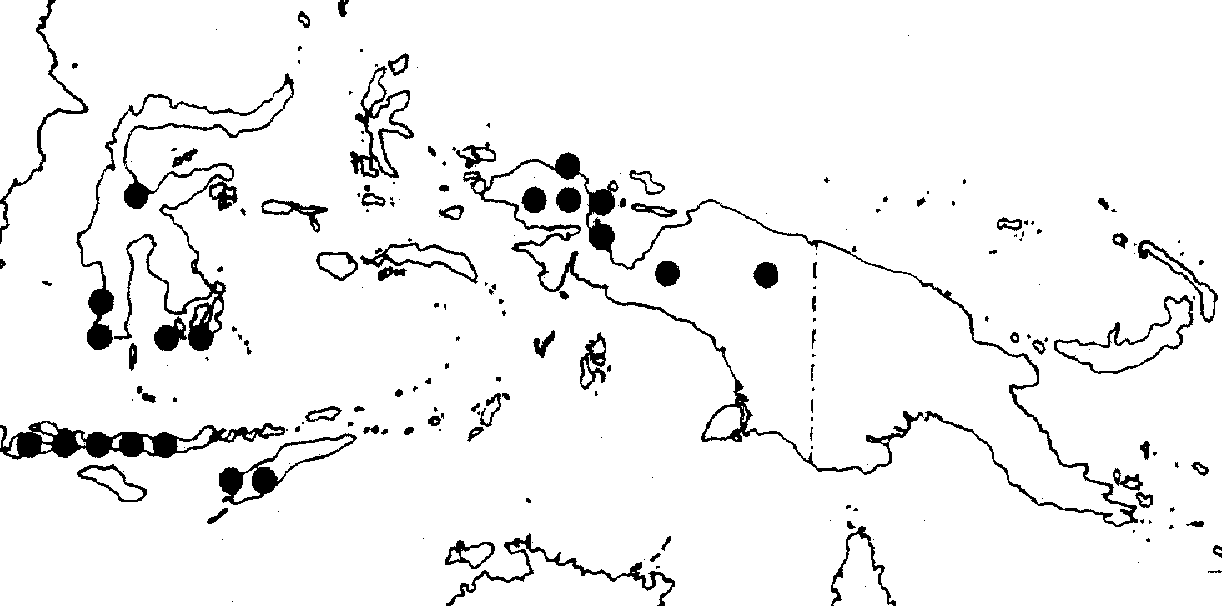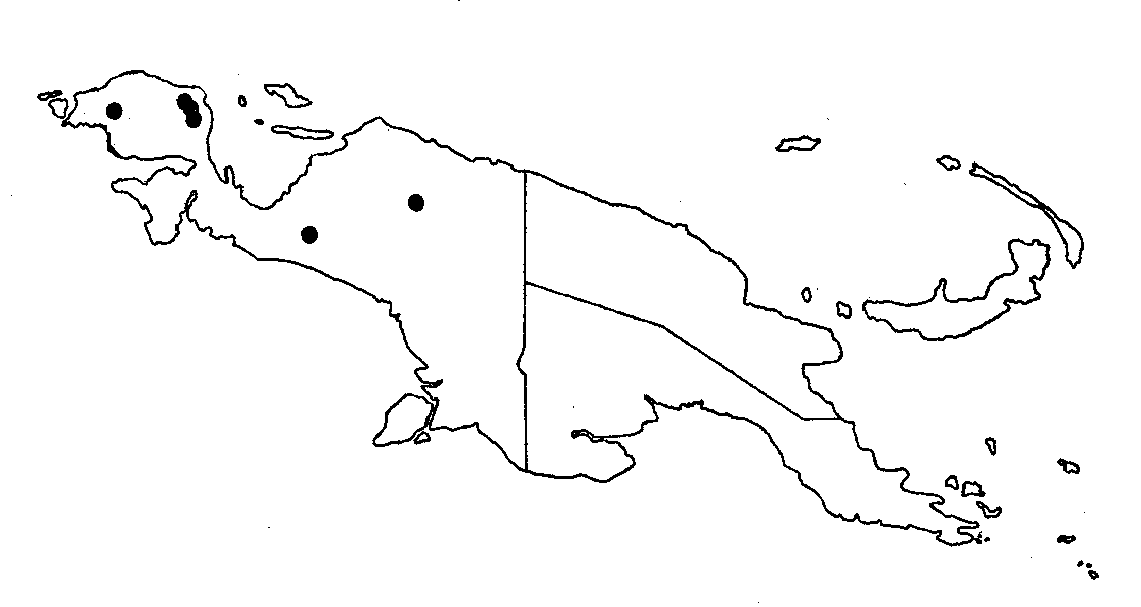
Distribution Map (Barlow 1993)

Description (Barlow 1993)
Decaisnina sumbawensis (Tieghem) Barlow, comb. novo
Amylotheca sumbawensis Tieghem, Bull. Soc. Bot. France 41 (1894) 265. - Type: Zollinger 3425 (holo P, not seen; iso L), Lesser Sunda Islands, Sumbawa.
Loranthus boholensis Merrill, Philipp. J. Sci. C 4 (1909) 141. - Amylotheca boholensis (Merrill) Danser, Bull. Jard. Bot. Buitenzorg III, 10 (1929) 300. - Type: McGregor BS 1277 (lecto NY, see below; iso P, US), Philippines, Bohol, vii.1906.
Loranthus formicariwn Elmer, Leafl. Philipp. Bot 3 (1911) 1069; Amylotheca formicaria (Elmer) Danser, Bull. Jard. Bot Buirenzorg III, 10 (1929) 301. - Type: Elmer 11304 (lecto L, see below; iso BO, NY, US), Philippines, Mindanao, Davao, Todaya, Mt Apo, viii. 1909.
Loranthus agusanensis Elmer, Leafl. Philipp. Bot 6 (1913) 1962. - Amylotheca agusanensis (Elmer) Danser, Bull. Jard. Bot. Buitenzorg III, 10 (1929) 300. - Type: Elmer 13405 (lecto L, see below), Philippines, Mindanao, Agusan, Cabadbaran, Mt Urdaneta, vii.1912.
Loranthus terminaliflorus Elmer, Leafl. Philipp. Bot. 6 (1913) 1970. - Type: Elmer 14156 (lecto L, see below), Philippines, Mindanao, Agusan, Cabadbaran, Mt Urdaneta, near L Donao, 1500 m, x.1912.
Amylotheca parvifolia Danser, Bull. Jard. Bot. Buirenzorg III, 11 (1931) 248. - Decaisnina parvifolia (Danser) Barlow, Austral. J. Bot 22 (1974) 541. - Type: Mayr 51 (lecto B), New Guinea, Arfak Mts, 1400 m, 30.v.1928.
For descriptions and additional synonymy see Danser, Philipp. J. Sci. 58 (1935) 12, 16, under Amylotheca boholensis and A. formicaria; Barlow, Austral. J. Bot. 22 (1974) 541, under D. parvifolia. The essential elements of an integrated description are as follows: Glabrous except for the inflorescence rarely sparsely pubescent. Stem internodes sometimes slightly angular when young, soon becoming terete. Leaves opposite; lamina narrowly elliptic or ovate to broadly ovate, (2-)5-14(-18) cm long, (1-)2-6(-7) cm wide, cuneate to truncate at the base to a petiole (2-)3-12 mm long, distinctly bifacial from an early stage, shining or often varnished above, dull below, usually acuminate but sometimes acute or in smaller leaves even rarely obtuse at the apex; midrib and lateral venation usually distinct on both sides. Inflorescence axillary; axis usually slender, (14-)20-40 mm long, bearing 4-6 pairs of secund triads uniformly spaced above a flowerless basal part 4-15 mm long; peduncles of the triads 1.5-3 mm long; triads with all flowers sessile or the lateral flowers on very short pedicels to 0.5 mm long. Ovary narrowly cylindrical or urceolate, 2-2.5 mm long; calyx limb c. 0.2 mm long, weakly toothed. Corolla in mature bud slender, 22-30 mm long, weakly inflated at the base, acute at the apex; petals coherent in the lower 1-3 mm after anthesis. Anther 2-3 mm long, usually slightly shorter than the free part of the filament. Style articulate c. 0.5 mm above the base; stigma globular, twice as wide as the style. Fruit ellipsoid, c. 8 mm long, crowned by the calyx limb.
Decaisnina sumbawensis has few specialized characters, and thus presents a relatively generalized facies for the genus. The species can be identified by its combination of petiolate, distinctly bifacial leaves cuneate to truncate at the base, inflorescence of slender flowers in triads uniformly spaced along the axis, corolla 22-30 mm long with a slight, transitory inflation at the base, and anther shorter than the free part of the filament. The flower colour is mostly described as various shades of red in the lower part and green or yellow above, sometimes with a purple band near the tip.
The species is widely distributed from the Philippines (Luzon to Mindanao) to Celebes, Lesser Sunda Islands (Sumbawa, Flores, Timor) and western New Guinea (Fig. 8; 44 collections seen), at a range of elevations from sea level to 2400 m. Habitat details are poorly known; the species probably occurs widely in primary rain forests, secondary vegetation, and agricultural lands, and has been recorded as parasitic on Citrus, Coffea, Ficus, and Nothofagus.
Distribution Map, D. parvifolia (Barlow 1974)

Description
Decaisnina parvifolia (Dans.) Barlow, comb. nov.
Amylotheca parvfolia Dans. Bull. Jard. bot. Buitenz. 11: 248 (1931). Type.-Arfak Mts., 1400 m alt., Mayr 51, 30.v.1928 (B, lectosyntype, photo in AD); Arfak Mts., 1900 m alt., Mayr 9 (B, syntype, not seen, possibly destroyed).
Glabrous. Stems flattened and double-edged when young, often remaining angular when older. Petiole c. 1 cm long; lamina broad lanceolate to elliptical, 5-7-(10) by 2-2.5-(6) cm, shining above, dull below, gradually attenuate at the base, recurved at the margins, acute or obtuse at the apex; venation pennate with the midrib prominent below and other venation obscure. Inflorescences solitary in the axils; axis terete, bearing 6-7 pairs of triads, c. 3 cm long; peduncles of the triads 1-2 mm long; pedicels of the lateral flowers of the triads 0.5 mm long; bracts triangular, spreading, rounded at the apex, 1-1.5 mm long. Calyx narrow cylindrical, 2.5 mm long; limb entire or irregularly split, spreading, 0.7 mm long. Corolla in the mature bud slender, 25-30 mm long; petals in the open flower coherent in the lower 4-5 mm. Anthers 3 mm long, acuminate at the apex; free parts of the filaments equal to or longer than the anthers, sometimes flattened and wider than the anthers. Style articulate c. 0.5 mm above the base. Fruit not seen.
Occurrence. West Irian, from the Vogelkop to the Wissel Lakes (Fig. 2), from 1400 to 2400 m altitude.
Representative Specimens. WEST IRIAN Arfak Mts., path to Koebre via Tidjei, c. 2400 m alt., Sleumer and Vink 4443a, 28.i.1962 (L); south bank of L. Paniai, Wissel Lakes, 1750 m alt., Eyma 4531, Feb. 1939 (L).
See note under D. hollrungii.
Illustrations
Photographs
Decaisnina sumbawensis
updated 20 January 2007